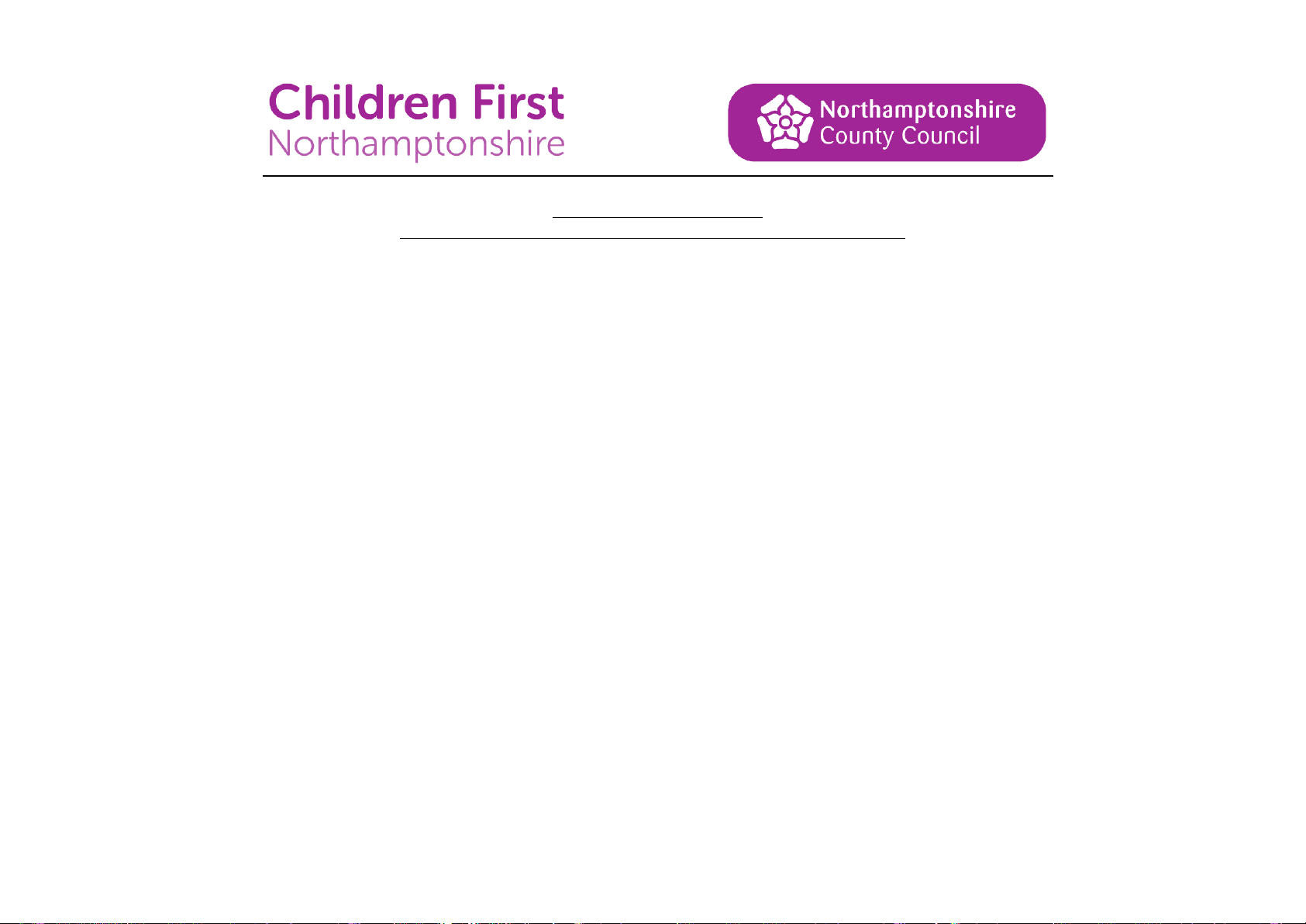
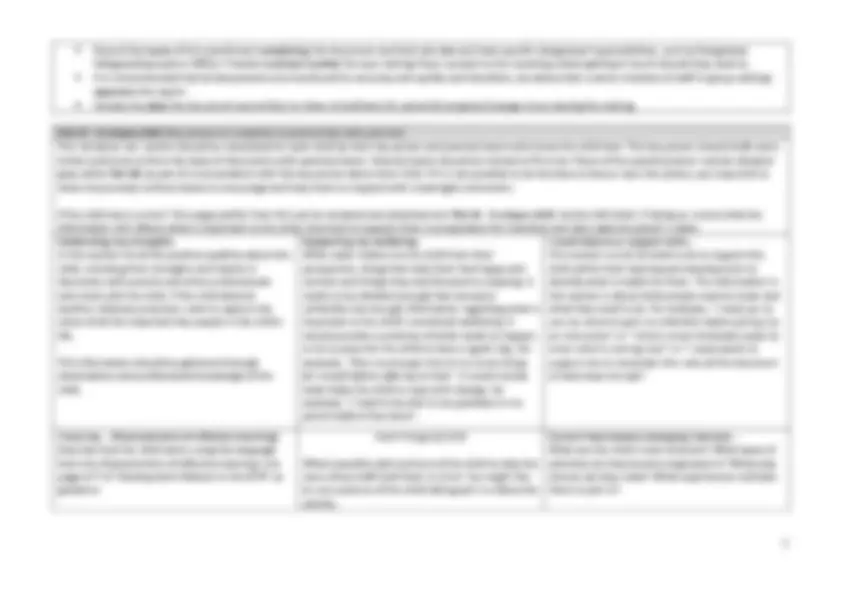
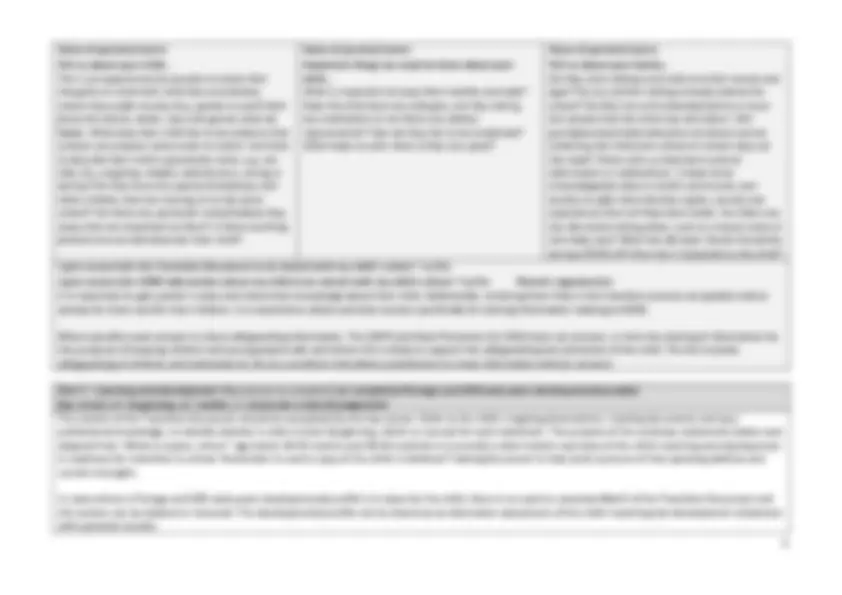
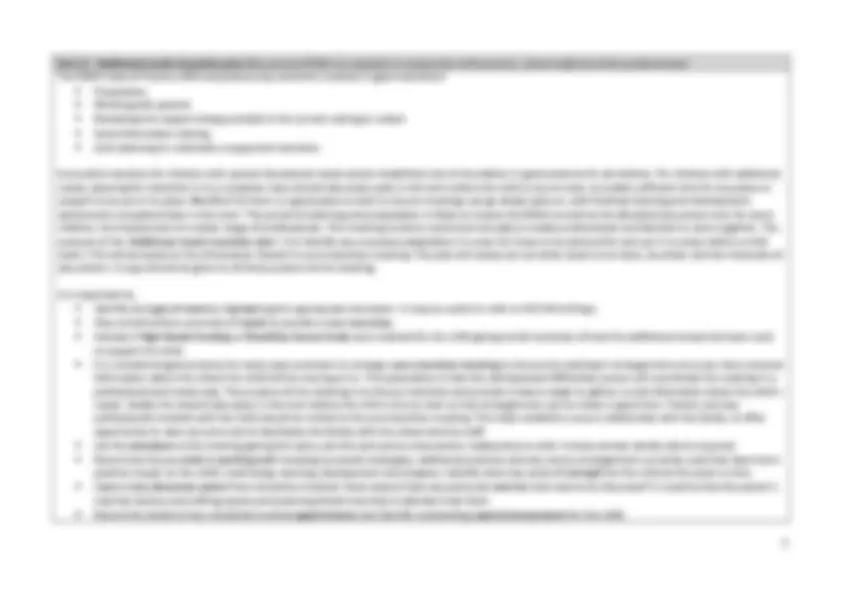
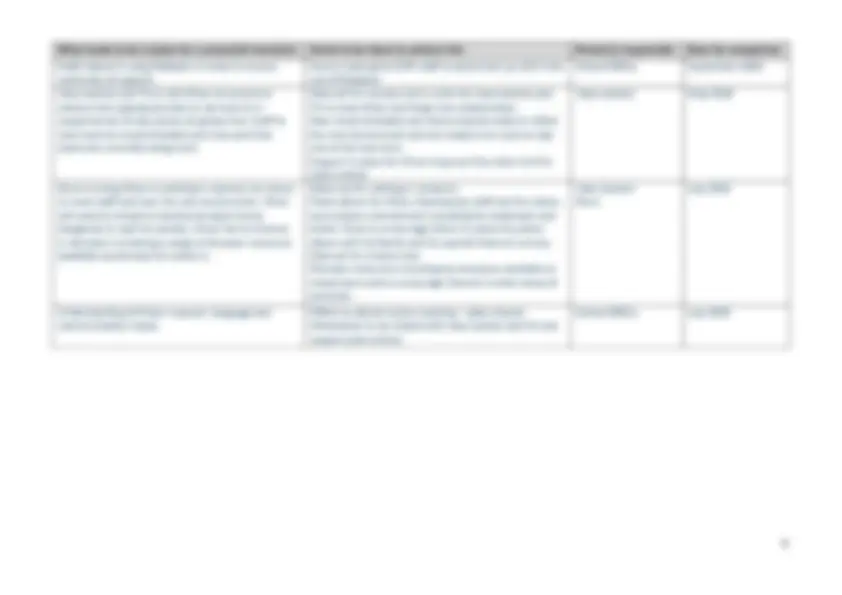


Study with the several resources on Docsity

Earn points by helping other students or get them with a premium plan


Prepare for your exams
Study with the several resources on Docsity

Earn points to download
Earn points by helping other students or get them with a premium plan
Community
Ask the community for help and clear up your study doubts
Discover the best universities in your country according to Docsity users
Free resources
Download our free guides on studying techniques, anxiety management strategies, and thesis advice from Docsity tutors
Guidance on completing the 'Transition Document – Moving on to school'. It emphasizes the importance of a quality transition process for children moving from early years providers to school. communication with key persons, identification of English as an additional language, sharing of information, and safeguarding. It also includes sections for celebrating children's strengths, parental input, and learning and development.
What you will learn
Typology: Summaries
1 / 8

This page cannot be seen from the preview
Don't miss anything!





Early Education and Childcare Guidance: Completing the ‘Transition Document – Moving on to school’
Children should be at the heart of all transition arrangements. Providing a quality transition process should not be underestimated for the impact it can have on a child’s future learning and development as they move on to school. Transitions should be considered as a continuous and evolving process adapted to meet the needs of the individual child and their families, not a one off event and therefore, the Transition Document should be completed as part of this process.
It is crucial that all professionals involved commit to partnership working and build strong relationships that foster positive communication and support smooth transitions. Early years providers, schools, parents and other professional agencies all have a shared responsibility to ensure that every child is ready to continue their learning journey as they enter school. A child who feels secure during and after the move will be more likely to engage with their new environment in a positive way and access the learning opportunities more readily.
Central to a successful transition is the appropriate and timely sharing of information with consent. Sharing of information enables professionals to be better prepared to provide services that are responsive and coordinated around the needs of the individual child. Through effective partnerships, children, parents and schools should promote children’s readiness for school and a school’s readiness for children. Parental permission must be gained prior to the Transition Document being transferred.
The Transition Document is a summative record and therefore, should reflect levels of attainment on leaving the setting, so should be completed towards the latter end of the summer term. Getting the timing right can be tricky, too soon and it is not a reflection of children’s true capabilities at the end of the academic year, often when there can be a surge in their progress. The information captured supports receiving staff to prepare for the child’s arrival in school and should be passed on before the end of term.
Once drafted the Transition Document should form the basis of discussions with parents/carers. Parents/carers should be invited to fill in the ‘ Voice of the parents/carers ’ section (shaded grey within Part B ) as part of a conversation with the key person. They should be given a copy of the finalised document as a record of how their child’s learning journey will be supported. All information in the form should be treated confidentially and it is the responsibility of the early years provider to ensure that the information is stored and transferred directly to the receiving school in a secure way. The document may be completed electronically in Word or the PDF version printed to complete by hand. It is recommended that the form is passed to the school at transition meetings and where this is not possible, any electronic transfer of data must conform to data security guidelines and not be emailed in an unprotected format.
Part A – General information (Key person to complete) This section comprises of all key information held about the child. Ensure all boxes are completed where relevant giving as much detail as possible to help build a secure picture of the child. It is important to: Ensure the child’s full name is used. Complete the child’s Date of Birth. Complete the child in care box as applicable if the child is looked after by the local authority. Record the name of your childcare provision. Identify the child’s age in months at the time the Transition Document is written to be able to quickly ascertain whether they are achieving expected levels of development for their age. Indicate if you have any ongoing safeguarding concerns about the child. Safeguarding children remains paramount during transitions. It is best to be open and honest with families from the outset about why, what, how and with whom information will or could be shared and seek their agreement unless it is unsafe or inappropriate to do so. Child protection information /documents should be given separately to the Transition Document and must be directly passed to the Designated Safeguarding Lead of the school. State the name of the child’s current key person so that communication can be made with them to best support the child moving on. Record the number of days and hours attended each week to build a picture of the child’s weekly childcare routine. Be clear when the child started at the setting to help show the length of their preschool experience. Identify if the child has English as an additional language ( EAL ) and specify the language(s) spoken so that schools have time to prepare for this. Share information about other regular childcare attended. It is usual for the setting where the child spends the most time to complete the Transition Document. You could plan to work in partnership with other providers, with the main provider taking the lead on gathering the information and views of all involved in the shared care and education of the child. By working collaboratively to inform one document it avoids school staff receiving two or more Transition Documents for one child. However, other settings attended by the child may complete the Transition Document should they wish to. If the child was with you at age two, please record when they had their EYFS Statutory Progress check at age two and if there were any concerns raised at the time. State the name of the receiving school so that appropriate transitions can be organised. Identify if the child has any additional needs or a disability. If they have, ensure you complete Part D of the Transition Document. If the child has no additional needs please disregard/delete Part D. Share the names of other professional services who already have involvement with the child and may need to be included in future support, for example, Speech and Language Therapists, Educational Psychologists or Health Visitors. Review the list of essential documents to send as part of this Transition Document. For each individual child, you should include their most recent Individual Tracking Document identifying their current stage of development under each aspect and the progress they have made whilst in your care. Where appropriate and based on the circumstances and needs of individual children you should attach additional documents. For children with additional needs you must seek parental consent to share this information. A more specific list of associated documents for children with SEND is listed in Part D. If the child has been in receipt of Early years pupil premium please identify the learning and development priorities or enhancement opportunities that were targeted using the additional funding.
Voice of parents/carers:
Tell us about your child… This is an opportunity for parents to share their thoughts on what their child likes and dislikes, where they prefer to play (e.g. garden or park) their favourite stories, books, toys and games when at home. What does their child like to be called so that schools can prepare name cards to match. Ask them to describe their child’s personality traits, e.g. are they shy, outgoing, helpful, adventurous, caring or daring? Do they have any special friendships with other children that are moving on to the same school? Are there any particular clubs/hobbies they enjoy that are important to them? Is there anything parents are worried about for their child?
Voice of parents/carers: Important things we need to know about your child… What is important to keep them healthy and safe? Does the child have any allergies, are they taking any medication or are there any dietary requirements? How do they like to be comforted? What helps to calm them if they are upset?
Voice of parents/carers: Tell us about your family… Do they have siblings and what are their names and ages? Do any of their siblings already attend the school? Do they live with extended family or have lots of pets that the child may talk about. Will grandparents/childminders/out of school club be collecting the child from school on certain days of the week? Share with us important cultural information or celebrations. It helps to be knowledgeable about a child's community and locality to offer them familiar sights, sounds and experiences that will help them settle. Are there any key life events taking place, such as a house move or new baby due? What has life been like for the family during COVID-19? How has it impacted on the child? I give consent for the Transition Document to be shared with my child’s school: Yes/No
I give consent for SEND information about my child to be shared with my child’s school: Yes/No Parent’s signature(s): It is important to gain parent’s views and share their knowledge about their child. Additionally, involving them fully in the transition process can greatly reduce anxiety for them and for their children. It is essential to obtain parental consent specifically for sharing information relating to SEND.
Where possible seek consent to share safeguarding information. The GDPR and Data Protection Act 2018 does not prevent, or limit the sharing of information for the purposes of keeping children and young people safe and where this is likely to support the safeguarding and protection of the child. The Act includes safeguarding of children and individuals at risk as a condition that allows practitioners to share information without consent.
Part C – Learning and development (Key person to complete) (or completed Portage and SEN early years developmental profile) Key: b/w/s, b = beginning, w = within, s = secure for a best fit judgement This section of the Transition Document should be completed by the key person. Refer to the child’s ongoing observations, tracking documents and your professional knowledge, to identify whether a child is b/w/s (beginning, within or secure) for each statement. The purpose of the summary statements (taken and adapted from ‘What to expect, when?’ age bands 30-50 months and 40-60 months) is to provide a short holistic overview of the child’s learning and development in readiness for transition to school. Remember to send a copy of the child’s individual Tracking Document to help build a picture of their growing abilities and current strengths.
In cases where a Portage and SEN early years developmental profile is in place for the child, there is no need to complete Part C of the Transition Document and this section can be deleted or removed. The developmental profile can be shared as an alternative assessment of the child’s learning and development milestones with parental consent.
Part D – Additional needs transition plan (Key person/SENCo to complete in conjunction with parents, school staff and other professionals) The SEND Code of Practice 2015 emphasises key elements involved in good transitions: Preparation Working with parents Reviewing the support being provided in the current setting or school Good information sharing Joint planning to undertake a supported transition.
Successful transition for children with special educational needs and/or disabilities has its foundation in good practice for all children. For children with additional needs, planning for transition in to a reception class should take place early in the term before the child is due to start, to enable sufficient time for any plans or support to be put in to place. Part D of the form is a good place to start to ensure meetings can go ahead early on, with finalised learning and development assessments completed later in the term. The period of planning and preparation is likely to involve the SENCo as well as the allocated key person and, for some children, the involvement of a wider range of professionals. This meeting could be conducted virtually to enable professionals and families to come together. The purpose of the ‘ Additional needs transition plan ’ is to identify any necessary adaptations in order for these to be planned for and put in to place before a child starts. This will be based on the information shared in a pre-transition meeting. The plan will clearly set out what needs to be done, by whom and the timescale of any actions. A copy should be given to all those present at the meeting.
It is important to: Identify the type of need by highlighting the appropriate descriptor. It may be useful to refer to NCC Mind Maps. Give a brief written summary of needs to provide a clear overview. Indicate if High Needs Funding or Disability Access Funds were claimed for the child giving a brief summary of how the additional money has been used to support the child. It is considered good practice for early years providers to arrange a pre-transition meeting to discuss the settling-in arrangements once you have received information about the school the child will be moving on to. The expectation is that the setting based SENCo/key person will coordinate the meeting in a professional and timely way. The purpose of the meeting is to discuss transition and provide a way to begin to gather crucial information about the child’s needs. Ideally this should take place in the term before the child is due to start so that arrangements can be made in good time. Parents and any professionals involved with the child should be invited to the pre-transition meeting. This helps establish a secure relationship with the family, to offer opportunity to raise concerns and to familiarise the family with the school and the staff. List the attendees at the meeting giving full name, job title and service area and/or relationship to child. Include contact details where required. Record and discuss what is working well including successful strategies, additional provision and any access arrangements currently used that have had a positive impact on the child’s well-being, learning, development and progress. Identify some key areas of strength for the child at this point in time. Capture key discussion points from all parties involved. Does anyone have any particular worries that need to be discussed? It could be that the parent’s may feel anxious and talking openly and planning ahead may help to alleviate their fears. Record the details of any scheduled medical appointments and identify outstanding reports / assessments for the child.
Appendix
Part D – Additional needs transition plan completed sample (Key person/SENCo to complete in conjunction with parents, school staff and other professionals) Type of need: communication and language, cognition and learning, social, emotional and mental health, sensory and physical Overview of need: Currently receiving speech and language therapy for delayed speech and expressive and receptive language needs Difficulty concentrating especially in group situations – this sometimes results in unwanted behaviour Difficulty coping with changes of routine In receipt of: High Needs Funding: Yes/No Disability Access Funding: Yes/No Additional funding has been use to improve outcomes by… Pre-transition meeting date: May 4th^2020 Attendees: (State name, job title/service/relationship to child and add contact details where required) Sarah Harris – Mum Helen Cox – Reception class teacher Steve White – School SENCo Sally Butler – Speech and language therapist Jo Brooks – Key person Sam Jones – Nursery SENCo Current strengths - What is working well for the child: Good relationship with key person Good friendship with one other child Use of visual timetable and now and then board Ongoing support from SALT Use of Makaton Key discussion points – What are we worried about: Anxiety about being in a new environment with new people Worries about making new friends and being able to communicate with them Sitting on the carpet for a long time Using different toilets Assessments/reports/appointments outstanding or planned: Speech and language review report 10/07/ Supporting documents shared: (With parental consent) Tracking document Yes/No Education Health and Care Plan Yes/No Portage and SEN early years developmental profile Yes/No Early Help Assessment Yes/No Assess, plan, do and review forms Yes/No Medical reports, care plan Yes/No Risk assessment Yes/No Specialist support services reports Yes/No One page profile Yes/No Other (please state)
What needs to be in place for a successful transition: Action to be taken to achieve this: Person(s) responsible: Date for completion:
Staff trained in using Makaton in order to ensure continuity of support.
Source training for EYFS staff to attend and up skill in the use of Makaton.
School SENCo September 2020
Class teacher and TA to visit Oliver at nursery to observe him playing and also to see how he is supported by his key person at group time. Staff to view how his visual timetable and now and then board are currently being used.
Date set for nursery visit in order for class teacher and TA to meet Oliver and forge new relationships. New visual timetable and choice boards made to reflect the new environment and are ready to be used on day one of the new term. Support in place for Oliver at group time when he first starts school.
Class teacher May 2020
Mum to bring Oliver to settling in session/s at school to meet staff and view the new environment. Oliver will need to bring his transitional object (a toy kangaroo) to ease his anxiety. Oliver has an interest in dinosaurs so having a range of dinosaur resources available would help him settle in.
Dates set for settling in session/s. Photo album for Oliver showing key staff and the indoor and outdoor environment including the cloakroom and toilets. Mum to encourage Oliver to share the photo album with his family and his special friend at nursery. Date set for a home visit. Dinosaur resources including toy dinosaurs available at school and used to encourage interest in other areas of provision.
Class teacher Mum
July 2020
Understanding of Oliver’s speech, language and communication needs.
SENCo to attend review meeting – dates shared. Information to be shared with class teacher and TA and support plan written.
School SENCo July 2020